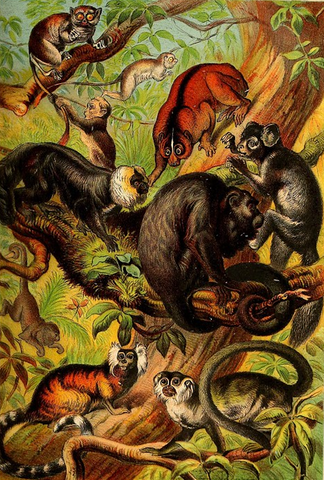The rainforest is one of the most fascinating ecosystems on Earth. It is a hot, moist environment home to an incredible diversity of plants and animals.
This blog post will focus on the rainforest ecosystem and explore some of its key components. We've also included some beautiful vintage illustrations of rainforest inhabitants.

Various monkeys; Spectrum Tarsier, Saki, Marmoset, Slow Lemur, Howling Monkey, Squirrel Monkey, Aye Aye
|
How Is A Rainforest Structured?
The rainforest is typically divided into four layers: the emergent, canopy, understory, and forest floor. The emergent layer is made up of tall trees that protrude above the canopy, which can reach heights of 200 feet or more. The canopy is the dense layer of foliage that forms the rainforest roof and comprises shorter trees, shrubs, and vines. It blocks sunlight, rainfall and wind to create a still, dark, humid atmosphere. The canopy is home to many animals and insects. The understory is the dark, shady layer beneath the canopy, the trees and plants here have broad leaves to catch the little sunlight that breaks through the dense layer above. The forest floor is the lowest layer of the rainforest, and this area is relatively free of vegetation due to the lack of light. Leaves and organic matter fall on the forest floor and decomposes to create a nutrient-rich organic matter known as humus.
The humus on the ground of a rainforest is a layer of decaying leaves, twigs, and other organic matter. This layer of rotting vegetation is an essential part of the rainforest ecosystem, which provides nutrients for plants and animals. The humus also serves as a home for many small creatures, such as insects and amphibians. It also humus helps to insulate the rainforest floor, keeping it cool and moist. Without this critical layer of organic matter, the rainforest would not be able to support a wide variety of plant and animal life.
 Heliconia Flower (Lobster-Claw) found in the understory layer.
Heliconia Flower (Lobster-Claw) found in the understory layer.
|
What Is A Rainforest Climate?
The climate of a rainforest can be variable, depending on the location and time of year. However, rainforests are generally hot and humid environments. The average temperature in a rainforest is around 80 degrees Fahrenheit, or 26 degrees Celsius. Rainforests receive a lot of rainfall – between 200-1000 centimetres annually. The rainforest generates rain through a process called transpiration. Transpiration occurs when plants release water vapour into the air, which condenses into clouds and eventually falls back down to the ground as rain. The transpiration process is essential to the rainforest ecosystem because it helps regulate the forest's temperature and moisture levels. Without transpiration, the rainforest would be sweltering and dry.
|
 Nest of a honey wasp attacked by a jaguar Nest of a honey wasp attacked by a jaguar
|
Which Animals Live in Rainforests?
Now that we've explored the rainforest climate and structure, let's take a closer look at how this ecosystem functions. A rainforest is home to an incredible diversity of plants and animals. These plants and animals have developed a unique relationship with one another. For example, some plants rely on animals for pollination, and others provide animal shelter or food. This symbiotic relationship is essential for the rainforest ecosystem to function correctly. The rainforest is also home to many different types of fungi and bacteria. These organisms play an indispensable role in the rainforest ecosystem. They help decompose dead plants and animals, releasing nutrients into the soil. This process is essential for the rainforest to stay healthy and thrive.
Rainforests are home to an incredible variety of animals. Among the most well-known rainforest dwellers are monkeys, parrots, and jaguars. However, many lesser-known animals call the rainforest home, including tree frogs, poison dart frogs, and sloths. The rainforest is also home to various insects, reptiles, and amphibians. It is estimated that rainforests are home to more than half of the world's animal species. This diversity is due in part to the rainforest's unique climate, which is warm and moist year-round. This provides an ideal habitat for many animals, who have adapted to take advantage of the abundant food and shelter. The rainforest is home to many rare and endangered species, making it a vital part of the global ecosystem.
 Tapir (Tapirus terrestris) Tapir (Tapirus terrestris)
|
What Are The Threats To Rainforests?
Rainforests are threatened by various sources; logging is the practice of cutting down trees for lumber, paper, and other products, destroying rainforest habitats. Logging also contributes to climate change by releasing greenhouse gases into the atmosphere. Choosing rainforest-friendly products such as bamboo furniture or recycled paper can help to reduce the pressure on rainforests. Another way to protect rainforests is to support policies and initiatives promoting sustainable management of rainforest resources, such as supporting indigenous communities with traditional knowledge of sustainable rainforest management or investing in research and development of new sustainable forestry practices.
Another significant threat to rainforests is agriculture. Farming takes up a lot of space, and as food demand increases, more rainforest land is destroyed for crops or pasture. Agriculture also pollutes rivers and streams, harming plant and animal life. To protect rainforests from agricultural development, we need to promote sustainable farming practices and reduce our consumption of animals.
 The two toed sloth The two toed sloth
|
Interested in Learning More?
This pictorial archive is a unique collection of rare 18th and 19th-century engraving and etchings. We've curated and restored 627 beautiful high-resolution images of lions prowling, tigers fighting, pumas stalking, hyenas hunting, deer rucking, bats, snakes, bison, antelope, eagles, swallows, owls, elephants, hippopotamus, walruses, apes, monkeys, marsupials, rodents, octopus, bears, rabbits, giant anteaters plus an extensive collection of animal skeletons and so much more. We're confident this book has the animal reference material you need.
Image Download Included:
Each book comes with a unique download link providing instant access to high-resolution files of the 627 images featured. These images can be used for tattoo designs, art and design projects, or printed and framed to make beautiful decorative artworks for your home or studio. A complimentary download of the Vault Editions Skulls and Anatomy sample pack is also included. Access this collection today and take your tattoo designs, illustrations and graphics to the next level.

 Heliconia Flower (Lobster-Claw) found in the understory layer.
Heliconia Flower (Lobster-Claw) found in the understory layer. Tapir (Tapirus terrestris)
Tapir (Tapirus terrestris) The two toed sloth
The two toed sloth


 Nest of a honey wasp attacked by a jaguar
Nest of a honey wasp attacked by a jaguar


